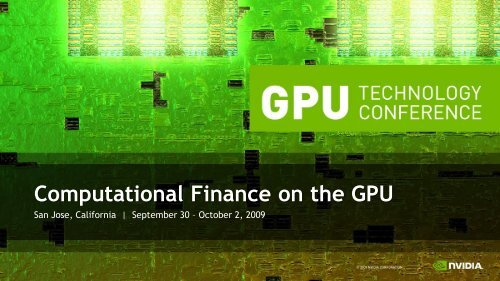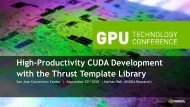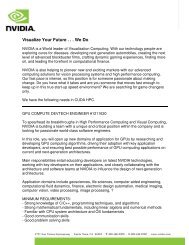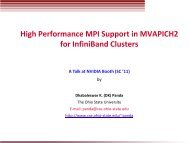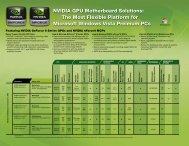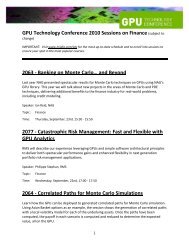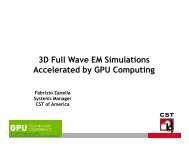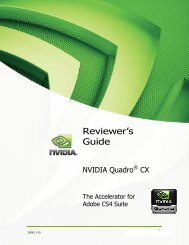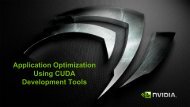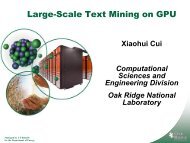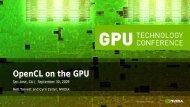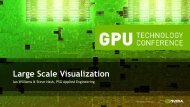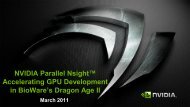Computational Finance on the GPU
Computational Finance on the GPU
Computational Finance on the GPU
Create successful ePaper yourself
Turn your PDF publications into a flip-book with our unique Google optimized e-Paper software.
<str<strong>on</strong>g>Computati<strong>on</strong>al</str<strong>on</strong>g> <str<strong>on</strong>g>Finance</str<strong>on</strong>g> <strong>on</strong> <strong>the</strong> <strong>GPU</strong><br />
San Jose, California | September 30 – October 2, 2009
Objective<br />
• Develop understanding of what<br />
“<str<strong>on</strong>g>Computati<strong>on</strong>al</str<strong>on</strong>g> <str<strong>on</strong>g>Finance</str<strong>on</strong>g>” means<br />
• Learn who uses <str<strong>on</strong>g>Computati<strong>on</strong>al</str<strong>on</strong>g> <str<strong>on</strong>g>Finance</str<strong>on</strong>g><br />
– Why do <strong>the</strong> users need it?<br />
– What do <strong>the</strong>y do with <strong>the</strong> informati<strong>on</strong>?<br />
• Take a look at some typical algorithms<br />
• C<strong>on</strong>sider <strong>the</strong> challenges and benefits of adopti<strong>on</strong>
AGENDA<br />
Financial Instruments<br />
Who’s Who<br />
Modeling<br />
Algorithms<br />
Adopti<strong>on</strong><br />
Summary
AGENDA<br />
Financial Instruments<br />
Who’s Who<br />
Modeling<br />
Algorithms<br />
Adopti<strong>on</strong><br />
Summary
Financial Instruments<br />
Cash Instruments<br />
Equities<br />
Commodities<br />
Fixed Income<br />
Foreign Exchange<br />
Derivatives<br />
Exchange-traded<br />
Over-<strong>the</strong>-counter
Equities<br />
• Share ownership<br />
• Value determined<br />
by market<br />
• Dividends
Commodities<br />
• Raw resource<br />
– Agriculture: corn, rice<br />
– Livestock: pork bellies<br />
– Energy: oil, gas<br />
– Metals: precious, industrial<br />
• Supply and demand
Fixed Income<br />
• Also: Credit<br />
• Loans and b<strong>on</strong>ds<br />
• Different rates<br />
according to durati<strong>on</strong>
Foreign Exchange<br />
• Also: Forex or FX<br />
• Take advantage of<br />
changes in rates
Derivatives<br />
• Based <strong>on</strong> <strong>on</strong>e or more underlying assets<br />
– Equities, FX, credit<br />
• Many types of c<strong>on</strong>tract<br />
– Forwards and futures<br />
– Opti<strong>on</strong>s<br />
– Swaps<br />
• Exchange-traded or Over-<strong>the</strong>-Counter (OTC)
Example: Opti<strong>on</strong>s<br />
• Holder has <strong>the</strong> right to<br />
buy (call) or sell (put)<br />
<strong>the</strong> underlying asset<br />
– By a certain date<br />
– At a certain price<br />
Payoff put<br />
where<br />
K<br />
S<br />
max( K<br />
strike<br />
spot<br />
price<br />
price<br />
S,<br />
0)<br />
Profit ($)<br />
2500<br />
2000<br />
1500<br />
1000<br />
500<br />
0<br />
-500<br />
0 10 20 30 40 50 60<br />
Stock price ($)
AGENDA<br />
Financial Instruments<br />
Who’s Who<br />
Modeling<br />
Algorithms<br />
Adopti<strong>on</strong><br />
Summary
Traders<br />
• Trading:<br />
– Standardised instruments<br />
– New (often complex) instruments<br />
• Requires models:<br />
– Pricing<br />
– Predicti<strong>on</strong><br />
– Risk analysis Traders Backoffice Quants Developers
Backoffice<br />
• M<strong>on</strong>itoring <strong>the</strong> banks exposure<br />
• Model all trades<br />
– Value<br />
– Risk<br />
• Value-at-Risk (VaR) required for regulati<strong>on</strong><br />
Traders Backoffice Quants Developers
Quants<br />
• Develop and implement models for traders<br />
• Develop independent models for validati<strong>on</strong><br />
• Research<br />
• Modelling exposure and capital<br />
Traders Backoffice Quants Developers
Developers<br />
• Implement models from quants<br />
• Integrate into larger applicati<strong>on</strong>s<br />
– Interface to o<strong>the</strong>r models<br />
– Interface to database<br />
– Interface to user<br />
Traders Backoffice Quants Developers
AGENDA<br />
Financial Instruments<br />
Who’s Who<br />
Modeling<br />
Algorithms<br />
Adopti<strong>on</strong><br />
Summary
Inputs/Outputs<br />
Instrument<br />
parameters<br />
Market<br />
data<br />
Value<br />
C<strong>on</strong>fidence<br />
Sensitivities
Traders<br />
• Determine price for trade<br />
– Negotiate over <strong>the</strong> ph<strong>on</strong>e, require results fast<br />
– Minimize out-trades (errors)<br />
• Run positi<strong>on</strong>s<br />
– Sensitivities allow trader to predict resp<strong>on</strong>se to changes in<br />
underlying assets<br />
– Run often to allow trader to react quickly<br />
Traders Backoffice Quants Developers
Backoffice<br />
• Manage risk and capital reserves for regulati<strong>on</strong><br />
– Large runs can take days to complete<br />
– Accurate results allow greater c<strong>on</strong>trol, and hence more trades<br />
• M<strong>on</strong>itor traders’ exposure<br />
– Run intra-day<br />
• Greater accuracy requires l<strong>on</strong>ger run times<br />
Traders Backoffice Quants Developers
AGENDA<br />
Financial Instruments<br />
Who’s Who<br />
Modeling<br />
Algorithms<br />
Adopti<strong>on</strong><br />
Summary
Analytic<br />
• Some derivatives have an analytic soluti<strong>on</strong><br />
f<br />
t<br />
rS<br />
f<br />
S<br />
1<br />
2<br />
2 2<br />
S<br />
2<br />
f<br />
2<br />
S<br />
rf<br />
Black -Scholes<br />
Formula<br />
• Compare analytical result with numerical result<br />
– Provides a C<strong>on</strong>trol Variate<br />
f<br />
d<br />
d<br />
1<br />
2<br />
Ke<br />
rT<br />
ln( S<br />
0<br />
(<br />
K)<br />
d<br />
2<br />
)<br />
( r<br />
T<br />
d )<br />
2)<br />
T<br />
ln( S0<br />
K)<br />
( r<br />
T<br />
2<br />
2)<br />
T<br />
d1<br />
Price for European Put Opti<strong>on</strong><br />
S<br />
0<br />
2<br />
(<br />
1<br />
T
Binomial Trees<br />
• Represent possible paths of stock<br />
• Assumpti<strong>on</strong>s:<br />
– Stock has a probability p of moving up<br />
by a certain percentage u<br />
– Stock has a probability (1-p) of moving<br />
down by a certain percentage d
Binomial Trees<br />
• C<strong>on</strong>struct <strong>the</strong> tree<br />
– Create a branch for each<br />
time step<br />
– At each node <strong>the</strong> stock<br />
can ei<strong>the</strong>r go up u% or<br />
down d%
Binomial Trees
Binomial Trees <strong>on</strong> <strong>the</strong> <strong>GPU</strong><br />
• Work backwards in time<br />
– Compute value at each<br />
node<br />
• Partiti<strong>on</strong> <strong>the</strong> work across<br />
<strong>the</strong> SMs<br />
– Overlap input data<br />
– Fit input partiti<strong>on</strong> in<br />
smem
Finite Differences<br />
• Solve <strong>the</strong> Partial Differential Equati<strong>on</strong> iteratively<br />
– Divide <strong>the</strong> life of <strong>the</strong> derivative into equal intervals<br />
of length Δt<br />
– Divide <strong>the</strong> range of stock prices [0,S max] into equal<br />
intervals of size ΔS<br />
• Work backwards in time, compute <strong>the</strong> value at<br />
each node
Finite Differences - Implicit<br />
• Relati<strong>on</strong>ship:<br />
– Three values at t and <strong>on</strong>e<br />
value at t + Δt<br />
• Always c<strong>on</strong>verges to<br />
soluti<strong>on</strong><br />
• Requires solving<br />
simultaneous equati<strong>on</strong>s
Finite Differences - Explicit<br />
• Relati<strong>on</strong>ship:<br />
– One value at t and three<br />
values at t + Δt<br />
• Compute nodes in<br />
parallel<br />
• Can diverge from<br />
soluti<strong>on</strong>
Explicit Finite Differences <strong>on</strong> <strong>the</strong> <strong>GPU</strong><br />
• Partiti<strong>on</strong> <strong>the</strong> grid across<br />
<strong>the</strong> SMs
Explicit Finite Differences <strong>on</strong> <strong>the</strong> <strong>GPU</strong><br />
• Partiti<strong>on</strong> <strong>the</strong> grid across<br />
<strong>the</strong> SMs<br />
• Each SM requires a<br />
“halo”<br />
– Halo size determines how<br />
many time steps in batch
Explicit Finite Differences <strong>on</strong> <strong>the</strong> <strong>GPU</strong><br />
• Partiti<strong>on</strong> <strong>the</strong> grid across<br />
<strong>the</strong> SMs<br />
• Each SM requires a<br />
“halo”<br />
– Halo size determines how<br />
many time steps in batch<br />
– After each batch,<br />
distribute new halos
M<strong>on</strong>te Carlo<br />
• Sample a random walk for <strong>the</strong> asset(s)<br />
• Calculate <strong>the</strong> payoff of <strong>the</strong> derivative<br />
• Repeat to get many sample payoff values<br />
• Calculate <strong>the</strong> mean payoff
M<strong>on</strong>te Carlo<br />
Asset price ($)<br />
110<br />
108<br />
106<br />
104<br />
102<br />
100<br />
98<br />
96<br />
94<br />
92<br />
90<br />
0 T<br />
Time<br />
10<br />
8<br />
6<br />
4<br />
2<br />
0<br />
-2<br />
-4<br />
-6<br />
-8<br />
-10<br />
Payoff ($)<br />
Expected<br />
payoff
M<strong>on</strong>te Carlo <strong>on</strong> <strong>the</strong> <strong>GPU</strong><br />
Generate<br />
Random Numbers<br />
• Distributi<strong>on</strong><br />
• Covariance<br />
Compute payoff<br />
for each path<br />
• Scenarios are<br />
independent<br />
Compute<br />
statistics<br />
• Reducti<strong>on</strong>
M<strong>on</strong>te Carlo – Multiple Kernels<br />
RNG Paths Payoffs Reduce<br />
parfor [0..T)<br />
for [0..N)<br />
genrand()<br />
Samples<br />
parfor [0..N)<br />
for [0..T)<br />
genpath()<br />
Paths<br />
parfor [0..N)<br />
payoff()<br />
Payoffs<br />
for [0..lg 2N)<br />
reduce()
M<strong>on</strong>te Carlo – Single Kernel<br />
parfor [0..N)<br />
for [0..T)<br />
genrand()<br />
addtopath()<br />
payoff()<br />
MC<br />
reducestep()<br />
Payoffs<br />
Reduce<br />
for [0..lg 2N)<br />
reduce()
AGENDA<br />
Financial Instruments<br />
Who’s Who<br />
Modeling<br />
Algorithms<br />
Adopti<strong>on</strong><br />
Summary
Software legacy<br />
• Milli<strong>on</strong>s of lines of code<br />
• Complex relati<strong>on</strong>ships between code blocks<br />
– E.g. Primary algorithm generates paths which are<br />
reused in multiple payoff models<br />
• Hundreds of man-years of work<br />
• Significant refactoring of applicati<strong>on</strong> required<br />
– Support/feed <strong>the</strong> parallelized algorithms
Educati<strong>on</strong><br />
• Parallel programming is paradigm shift<br />
– Quants are starting to rethink algorithms<br />
– Designing or reusing different algorithms/strategies<br />
• Reuse of libraries and frameworks<br />
– C<strong>on</strong>centrate <strong>on</strong> <strong>the</strong> core algorithm<br />
– Increasing number of libraries for random numbers,<br />
linear algebra, reducti<strong>on</strong> etc.
Case Study: Equity Derivatives<br />
15 15x Faster<br />
1<br />
2 Tesla S1070 16x Less Space<br />
500 CPU Cores<br />
$24 K 10x Lower Cost<br />
$250 K<br />
2.8 KWatts 13x Lower Power<br />
37.5 KWatts<br />
Source: BNP Paribas, March 4, 2009
Case Study: Equity Derivatives<br />
No need to<br />
compromise<br />
15 15x Faster<br />
1<br />
2 Tesla S1070 16x Less Space<br />
500 CPU Cores<br />
$24 K 10x Lower Cost<br />
$250 K<br />
2.8 190x kWatts Lower<br />
Power in Total<br />
13x Lower Power<br />
37.5 kWatts<br />
Source: BNP Paribas, March 4, 2009
Case Study: Real-time Opti<strong>on</strong>s<br />
1 Same Performance<br />
1<br />
3 Tesla S870 9x Less Space<br />
600 CPU Cores<br />
$42 K 6x Lower Cost<br />
$262 K<br />
$140 K 9x Lower Annual Cost<br />
$1,200 K<br />
Figures assume:<br />
• NVIDIA Tesla S870s with <strong>on</strong>e 8-core host server per unit<br />
• CPUs are 8-core blade servers; 10 blades per 7U<br />
• $1,800/U/m<strong>on</strong>th rack and power charges, 5-year depreciati<strong>on</strong>
Case Study: Security Pricing<br />
2 hours 8x Faster<br />
16 hours<br />
48 Tesla S1070 10x Less Space 8000 CPU Cores<br />
Source: Wall Street & Technology, September 24, 2009
AGENDA<br />
Financial Instruments<br />
Who’s Who<br />
Modeling<br />
Algorithms<br />
Adopti<strong>on</strong><br />
Summary
C<strong>on</strong>clusi<strong>on</strong><br />
• Computers are used to model financial instruments for<br />
price, sensitivity and risk<br />
• Algorithms include Finite Differences and M<strong>on</strong>te Carlo<br />
• Parallelising algorithms requires structural support from<br />
<strong>the</strong> applicati<strong>on</strong><br />
– Benefit is substantial <strong>on</strong> all measures<br />
– <strong>GPU</strong>s are transforming <strong>the</strong> industry<br />
• Opportunities for algorithmic development
Resources<br />
• GTC presentati<strong>on</strong>s<br />
– <str<strong>on</strong>g>Finance</str<strong>on</strong>g> presentati<strong>on</strong>s, Thursday from 2pm, A<strong>the</strong>rt<strong>on</strong> Room<br />
– 3D Finite Differences <strong>on</strong> <strong>GPU</strong>, Friday 10.30am, Empire Room<br />
– Tridiag<strong>on</strong>al solvers <strong>on</strong> <strong>GPU</strong>, Friday 2pm, A<strong>the</strong>rt<strong>on</strong> Room<br />
• SDK examples<br />
– binomialOpti<strong>on</strong>s, 3DFD, M<strong>on</strong>teCarlo/M<strong>on</strong>teCarloMulti<strong>GPU</strong><br />
• NVIDIA finance page (links to <strong>on</strong>line resources)<br />
– http://www.nvidia.com/object/computati<strong>on</strong>al_finance.html


